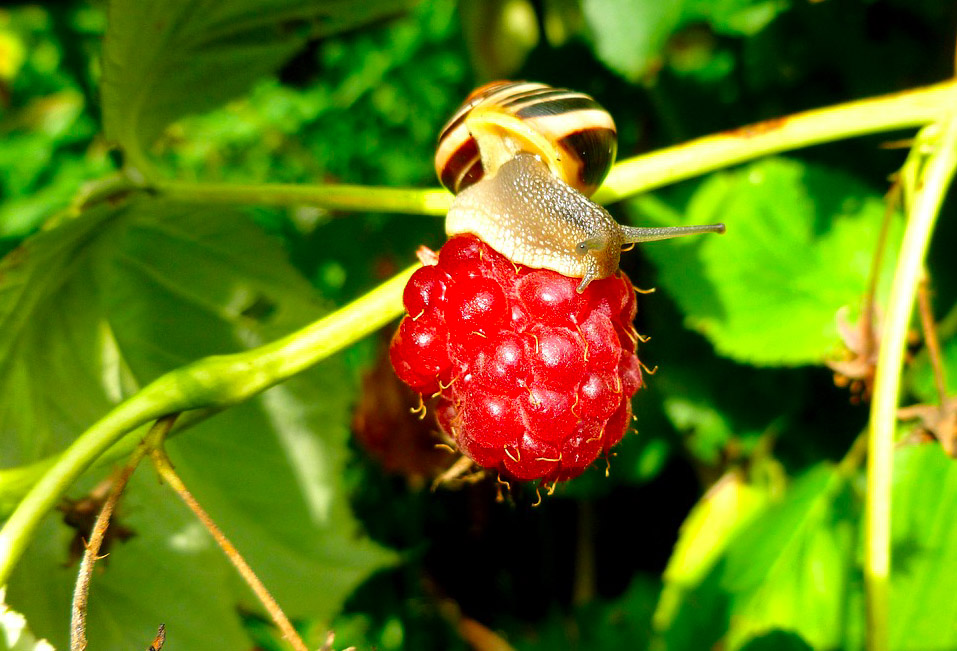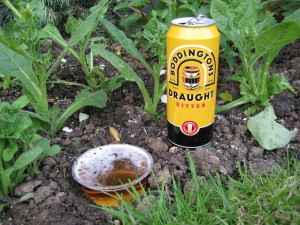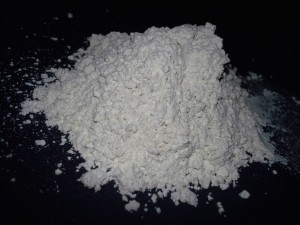Battling an excess of slugs and snails

Garden snail on raspberry. PhotoMax Pixel, public domain
We are all affected by the weather to one extent or other, and the unending rain this season has many folks, gardeners especially, feeling sluggish. Most people can handle that, but if the wet conditions make you feel snail-ish as well, it can really get on your nerves.
We had a free pass on snail and slug issues last year because it was so dry. These critters need a bit of dampness just to survive, and require a lot of moisture to reproduce successfully, so 2016 did not go very well for them. This year, however, is a different story. We had the wettest May ever recorded, got near-record rainfall in June, and are having a fairly soggy July so far. This has resulted in a shortage of suntans and a surplus of slimy critters.
In some locations, snails are so abundant that they crunch underfoot every time a homeowner steps outside. Although the ick-factor alone is enough to complain about, slugs and snails are a hungry lot, and have damaged gardens, landscapes, and even forage crops like alfalfa. Home gardeners are not the only ones battling slugs and snails, which are ravaging commercial produce fields, and have even found their way into greenhouses.
Tim “Guy” Drake from the Heuvelton area is a regular vendor at the Canton Farmers’ Market who grows and sells perennial flowers and shrubs. Because his native-strain landscape plants can be difficult to find elsewhere, he is extra cautious about protecting his stock from slug and snail damage. He told me that this year is the first time he has seen high numbers of these pests climb onto his elevated beds, which have always thwarted them in the past. “They’re relentless this year,” he says.

Beer is effective against snails and slugs as well as brain cells. Photo: SteveR, Creative Commons, some rights reserved
Controlling snails and slugs can be frustrating, because bug spray is not effective against them. They are not insects, but rather mollusks, and their mucus covering shields them from most insecticides. The time-honored remedy for dealing with them is beer, which helps gardeners feel a little better about the situation.
Beer also kills slugs and snails, which during the night are enticed into shallow dishes of brew, in which they drown. This works if mollusk populations are low, but some properties are overrun by literally thousands of snails. Not only would it take a lot of pie tins full of beer to put a dent in such a crowd, the bait would need refreshing every time it rained. After the first few kegs appear in the garden, the neighbors might start to talk.
You can also trap mollusks by placing overturned grapefruit skins, asphalt shingles, or lumber scraps on the soil. They will gather under these things in dry, sunny conditions (don’t laugh—this happens occasionally), and you can pick up the “traps” and kill the critters hiding underneath.

Diatomaceous earth can create a scratchy barrier between slugs and their garden prey. Photo: SprocketRocket, Creative Commons, some rights reserved
Diatomaceous earth (DE) is a nontoxic powder made of the pulverized shells of diatoms, a type of microscopic plankton. It acts like an extremely sharp sand, puncturing the bodies of snails and slugs as they pass over it. You can sprinkle a protective barrier of DE around your plants, or around the border of a bed. Be careful not to breathe the dust, which can cause respiratory irritation. The downside to DE is that it needs to be replenished after every hard rain.
A 2010 Cornell research project done by Christy Hoepting and Kathryn Klotzbatch found that using a pepper-based deer repellant keeps away slugs at least as well as chemical treatments, and is a lot cheaper. It is not yet labeled for such use, however. They also found that high-nitrogen fertilizers such as urea kill slugs and their eggs as well. An old fact sheet I came across suggested applying a 10% ammonia solution to the perimeter of a garden bed in early summer. This apparently can kill juvenile slugs and eggs. Just be aware it is a source of nitrogen, so reduce your normal fertilizer rate.
There are also commercial slug baits that work well. Metaldehyde is an older chemical, effective but very toxic. Products with this active ingredient should be used away from pets and children. Iron phosphate is a fairly new active ingredient. It is quite effective, and has very low toxicity. One issue with it is that it dissolves in the rain. In a year like 2017 you may have to cut the end off a drink bottle to make little feeding stations, but it works best broadcast on the ground.
In November 2013, Cornell highlighted one of its mollusk researchers in its “Cornell Chronicle” magazine. Dr. Marla Coppolino is considered one of the foremost authorities in North America on snails. Among other accomplishments, she has consulted on films and TV programs involving snails in some way shape or form, earning her the title “Snail Wrangler.” As impressive as that is, what we need now is a “Snail Whisperer” to convince the invading mollusks to leave the area.
For more information on slug and snail control, contact your local Cornell Cooperative Extension office.
Paul Hetzler is a horticulture and natural resources educator with Cornell Cooperative Extension of St. Lawrence County.
Tags: garden pests, slugs, snails








Hello, enjoyed the above re slugs. I live in Raleigh, NC (originally from NY (Malone, Owls Head, L.I.), and every summer my garden has been inundated with slugs. But, not this year. I saw a few in the spring, but have not seen one in at least 2 mos. However, I am not complaining. I found beer to be the best, but Nellie, my pet, also loves beer, so, it was “first come, first served.”
Kathi